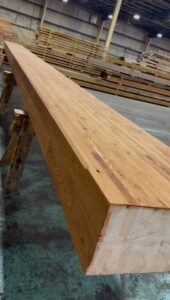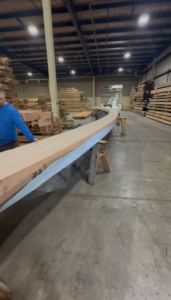When it comes to timber framing, most people picture massive solid timbers cut and joined with traditional mortise-and-tenon joinery. While that image holds true in many cases, Timbercraft also relies on engineered wood products to expand design possibilities and improve performance for our clients. One of the most important of these products is glulam, short for glued laminated timber.
What Are Glulams?

Glulams are structural members made by laminating layers of dimensional lumber together with durable, moisture-resistant adhesives. Instead of relying on a single large timber cut from one tree, glulams combine many smaller pieces of wood into a beam that is stronger, more stable, and often more sustainable.
Because the layers (or “laminations”) are bonded under pressure, glulams can be produced in long spans and curved shapes that would be impossible—or prohibitively expensive—to achieve with solid timbers.
How Glulams Are Made
The process of creating a glulam involves:
-
Lumber Selection – Boards are kiln-dried and visually or mechanically graded to ensure quality.
-
Moisture Control – The lumber is dried to a consistent moisture content to prevent warping or twisting.
-
Adhesive Application – A strong, water-resistant glue is applied to each layer.
-
Pressing – The layers are stacked and pressed under controlled pressure until the adhesive cures.
-
Shaping & Finishing – Once cured, the glulam beam can be planed, cut, or curved to meet the specific needs of a design.
This process creates a highly uniform, predictable product that retains the beauty of natural wood while offering superior strength.

When Are Glulams Used in Timber Framing?
Glulams are particularly valuable in situations where solid sawn timbers are impractical or unavailable:
-
Long Spans – In great rooms, vaulted ceilings, or large open floor plans, glulams provide the strength to cover wide distances without the need for intermediate supports.
-
Curved Designs – Arched entries, sweeping rooflines, and artistic architectural features are possible with bent glulams.
-
Heavy Loads – Roofs with large snow loads or structures requiring extra strength often call for glulam beams.
-
Material Efficiency – Using smaller boards reduces waste and makes use of lumber that might otherwise not be suitable for large timbers.
-
Sustainability – Because glulams use multiple smaller pieces of wood, they often come from faster-growing species, making them an environmentally friendly option.
Glulams vs. Solid Timbers
While glulams don’t carry quite the same rustic character as a solid hand-hewn timber, they offer benefits that can’t be ignored. They are straighter, less prone to checking or twisting, and available in sizes and shapes beyond what nature alone can provide. Some Timbercraft timber frame homes incorporate both: traditional timbers with housed mortise and tenon joinery for visible character, and glulams for structural spans where performance matters most. Utilizing glulams in place of timbers can broaden the flexibility of design and assist in supplying our clients with exactly what they expect out of their dream home.
Bringing It All Together
Glulams represent the perfect blend of modern engineering and traditional craftsmanship. They allow timber framers to build bolder, stronger, and more creative structures while still showcasing the natural warmth of wood. Whether you’re designing a dramatic vaulted great room, a sweeping arched entryway, or simply need the reliability of a straight, strong beam, glulams are often the hidden hero of timber framing.
